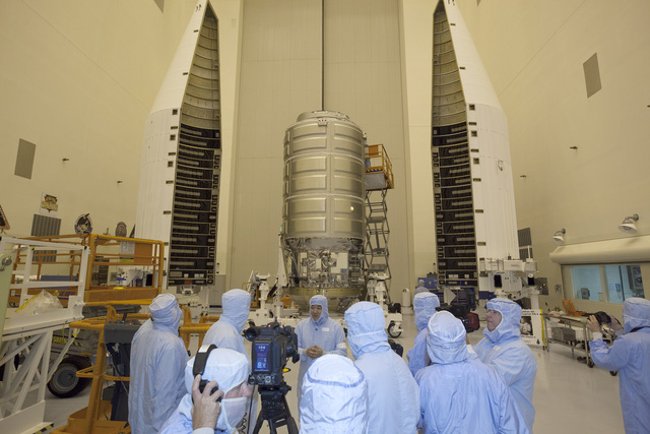The supply ship for ISS departed this morning in Vietnam time
It has been 13 months since the missile Antares brought along the ship Cygnus exploded during the supply mission for the ISS International Space Station. After more than a year of troubleshooting, today, Cygnus's next flight will be restarted by NASA and their partner Orbital ATK.
Orbital ATK restarted a cargo flight to ISS
Orbital ATK and SpaceX are currently the only commercial suppliers for NASA flights to transport goods to the ISS International Space Station. However, there seems to be a bad luck pursuing two American space carriers. More than a year ago was Orbital ATK's Antares missile explosion and in late June, SpaceX also failed to test the Falcon 9 launch.

The Antares missile exploded in last year's mission.
All American flights to ISS were interrupted from April 14, after SpaceX's final CRS-6. This caused astronauts on the International Space Station to be in a shortage of supplies and equipment, although several Russian and Japanese supplies were made.
It can be seen that there is a great pressure on Cygnus's flight. Not only is it to solve the problem of necessities for ISS, if the flight is successful, this will be the mark marking the return of the US as a regular supplier to the International Space Station.
Therefore, to ensure that the incident does not happen again, Orbital ATK used a traditional rocket instead of their Antares prototype. Cygnus will fly with Atlas V, a much more reliable missile. " This is an important milestone, the return of Cygnus marks the regular US presence in the ISS cargo mission," said Randy Gordon, NASA's flight support project director.

Cygnus has a little upgrade compared to the previous year.
This year's Cygnus flying version has a bit of an upgrade over the previous generation. The length of the train has dropped to more than 6m. However, it is capable of transporting 25% more goods than last year's version. Solar cell systems also have changes in design and operation. The panels are lighter and will spread out arc shapes rather than traditional rectangular arrays.
This time, NASA will send ISS a series of experimental instruments, with a remarkable focus on new devices that help research bacteria and microorganisms. The packages were packed long before, so they could not send more parts to overcome a recent power outage on the ISS.
This Cygnus ship is called SS Deke Slayton II , named after an astronaut in NASA's Mercury 7 project. SS Deke Slayton II is expected to leave the launch pad at 5:55 pm EST, around 5:55 am on December 4 in Vietnam time.
- Dragon spacecraft brought many specimens back to Earth
- ISS paves the way to welcome new supply ships
- Europe launched George Lemaitre transport ship to ISS
- Dragon private ship is about to return to Earth
- The ship Albert Einstein ends
- The ship Albert Einstein caught fire on the Pacific Ocean
- Supply seawater treatment machine to fresh water for fishermen
- Japan launched a cargo supply ship to ISS
- Russia launched new missiles on orbit
- SpaceX's boosters fell into the sea during a supply flight to ISS
- Kounotori 5 Japanese transport ship leaves ISS to return to Earth
- Attached 'eyes' to Kibo laboratory
 Van Allen's belt and evidence that the Apollo 11 mission to the Moon was myth
Van Allen's belt and evidence that the Apollo 11 mission to the Moon was myth The levels of civilization in the universe (Kardashev scale)
The levels of civilization in the universe (Kardashev scale) Today Mars, the sun and the Earth are aligned
Today Mars, the sun and the Earth are aligned The Amazon owner announced a secret plan to build a space base for thousands of people
The Amazon owner announced a secret plan to build a space base for thousands of people NASA is worried about mutant bacteria in the Space Station spreading to Earth
NASA is worried about mutant bacteria in the Space Station spreading to Earth  Interesting things about the most expensive international space station in human history
Interesting things about the most expensive international space station in human history  See where the ISS station is right now with these simple websites
See where the ISS station is right now with these simple websites  What would the space station be without Russia?
What would the space station be without Russia?  Russia launches 'dock' to the International Space Station
Russia launches 'dock' to the International Space Station  How to bring the International Space Station back to Earth?
How to bring the International Space Station back to Earth? 